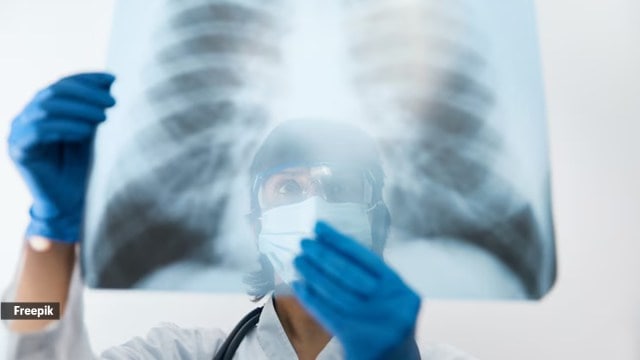📣 For more lifestyle news, click here to join our WhatsApp Channel and also follow us on Instagram
World Pneumonia Day 2024: All you need to know about the four varied forms of this deadly infection
Understanding these differences can be critical for determining the best treatment and taking preventative measures.
 What are the four types of pneumonia? (Source: Freepik)
What are the four types of pneumonia? (Source: Freepik)Pneumonia is often considered a single illness, but it comes in several forms, each with its causes and health implications. While all types of pneumonia involve an infection in the lungs, the specifics of each type can vary widely depending on how the infection is contracted and which organisms are involved. Understanding these differences can be critical for determining the best treatment and taking preventative measures.
The four types of pneumonia
Dr Vibhu Kawatra, senior consultant pulmonologist and sleep expert at Vibhu Nursing Home, tells indianexpress.com, “Pneumonia is an infection of the lungs that can be caused by a variety of pathogens, including bacteria, viruses, fungi, and parasites. The causes of pneumonia can vary based on the type and the conditions in which the infection develops.”
Here are four significant types of pneumonia and how each is caused, according to Dr Kawatra:
| Type of Pneumonia | Cause | Transmission |
|---|---|---|
| Bacterial Pneumonia | The most common cause of bacterial pneumonia is Streptococcus pneumoniae, but it can also be caused by other bacteria, such as Haemophilus influenzae, Staphylococcus aureus, and Mycoplasma pneumoniae. | Typically spread through respiratory droplets when an infected person coughs or sneezes. It can also develop after a viral respiratory infection weakens the lungs’ defenses, making them more susceptible to bacterial invasion. |
| Viral Pneumonia | It is caused by several viruses, the most common being influenza, respiratory syncytial virus (RSV), coronaviruses (e.g., SARS-CoV-2), and adenoviruses. | Transmitted via airborne droplets from coughing, sneezing, or talking. The virus can also be spread through contact with contaminated surfaces. |
| Aspiration Pneumonia | Occurs when food, liquid, or vomit is inhaled into the lungs, leading to infection. This can happen if the normal swallowing reflex is impaired due to neurological conditions (e.g., stroke, dementia), sedation, or alcohol intoxication. | Not typically transmitted from person to person. It arises from inhaling material from the mouth or throat, which can contain bacteria such as Anaerobes, Streptococcus pneumoniae, or Enterobacteriaceae. |
| Fungal Pneumonia | Can be caused by several types of fungi, including Histoplasma capsulatum, Coccidioides immitis, Blastomyces dermatitidis, and Cryptococcus neoformans. | Typically occurs when fungal spores are inhaled from the environment, often from soil or decaying organic matter. |
 Viral pneumonia can be difficult to manage in severe cases (Source: Freepik)
Viral pneumonia can be difficult to manage in severe cases (Source: Freepik)
Severity and treatment
Dr Kawatra says fungal pneumonia is “the most difficult to treat, especially in immunocompromised individuals.” Fungal infections can be chronic, often require extended therapy, and have a higher risk of resistance and relapse. Some fungal pathogens resist standard antifungal treatments, and the therapy can have significant side effects. Long-term antifungal therapy is required, with supportive care, particularly if respiratory distress is present.
“Aspiration pneumonia can also be challenging because it often involves mixed infections, including anaerobic bacteria, which can be harder to treat. Left untreated, complications like abscesses or empyema (infection in the pleural space) may lead to complications. Recurrence is common if the underlying cause (e.g., swallowing dysfunction) is not addressed,” he adds. Treatment includes broad-spectrum antibiotics for aerobic and anaerobic bacteria, and supportive care like oxygen therapy or mechanical ventilation if needed.
Dr Kawatra says viral pneumonia can be difficult to manage in severe cases, especially with viruses like influenza or COVID-19, which may lead to respiratory failure. However, in healthy individuals, viral pneumonia often resolves independently with supportive care.
Bacterial pneumonia is typically the easiest to treat, especially with sensitive organisms like Streptococcus pneumoniae, responding well to antibiotics. “The challenge arises with resistant strains (e.g., MRSA or Pseudomonas aeruginosa), which may require more potent antibiotics,” he says, adding that treatment includes antibiotics, with the choice based on the suspected pathogen and patient factors. In severe cases, IV antibiotics, oxygen therapy, or ventilatory support may be necessary.
DISCLAIMER: This article is based on information from the public domain and/or the experts we spoke to. Always consult your health practitioner before starting any routine.
📣 For more lifestyle news, click here to join our WhatsApp Channel and also follow us on Instagram
Photos


- 01
- 02
- 03
- 04
- 05
























